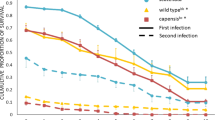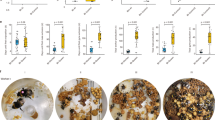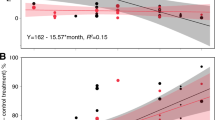Abstract
Relocation of the Cape honeybee, Apis mellifera capensis, by bee-keepers from southern to northern South Africa in 1990 has caused widespread death of managed African honeybee, A. m. scutellata, colonies1. Apis mellifera capensis worker bees are able to lay diploid, female eggs without mating by means of automictic thelytoky2 (meiosis followed by fusion of two meiotic products to restore egg diploidy), whereas workers of other honeybee subspecies are able to lay only haploid, male eggs. The A. m. capensis workers, which are parasitizing and killing A. m. scutellata colonies in northern South Africa, are the asexual offspring of a single, original worker in which the small amount of genetic variation observed is due to crossing over during meiosis3 (P. Kryger, personal communication). Here we elucidate two principal mechanisms underlying this parasitism. Parasitic A. m. capensis workers activate their ovaries in host colonies that have a queen present (queenright colonies), and they lay eggs that evade being killed by other workers (worker policing)—the normal fate of worker-laid eggs in colonies with a queen4,5,6,7,8. This unique parasitism by workers is an instance in which a society is unable to control the selfish actions of its members.
This is a preview of subscription content, access via your institution
Access options
Subscribe to this journal
Receive 51 print issues and online access
$199.00 per year
only $3.90 per issue
Buy this article
- Purchase on Springer Link
- Instant access to full article PDF
Prices may be subject to local taxes which are calculated during checkout


Similar content being viewed by others
References
Allsopp, M. H. & Crewe, R. M. The cape honey bee as a Trojan horse rather than the hordes of Genghis Khan. Am. Bee J. 133, 121–123 (1993).
Verma, S. & Ruttner, F. Cytological analysis of the thelytokous parthenogenesis in the Cape honeybee (Apis mellifera capensis Escholtz). Apidologie 14, 41–57 (1983).
Kryger, P. in Proc. 13th Entomol. Congr. S. Afrca (eds Olckers, T. & Brothers, D. J.) 38–39 (Entomological Society of Southern Africa, Pretoria, 2001).
Ratnieks, F. L. W. Reproductive harmony via mutual policing by workers in eusocial Hymenoptera. Am. Nat. 132, 217–236 (1988).
Ratnieks, F. L. W. & Visscher, P. K. Worker policing in the honey bee. Nature 342, 796–797 (1989).
Ratnieks, F. L. W. Egg-laying, egg-removal, and ovary development by workers in queenright honey bee colonies. Behav. Ecol. Sociobiol. 32, 191–198 (1993).
Barron, A., Oldroyd, B. P. & Ratnieks, F. L. W. Worker reproduction in honey-bees (Apis) and the anarchic syndrome: a review. Behav. Ecol. Sociobiol. 50, 199–208 (2001).
Visscher, P. K. Reproductive conflict in honey bees: a stalemate of worker egglaying and policing. Behav. Ecol. Sociobiol. 39, 237–244 (1996).
Ratnieks, F. L. W. Evidence for a queen-produced egg-marking pheromone and its use in worker policing in the honey bee. J. Apic. Res. 34, 31–37 (1995).
Oldroyd, B. P. & Ratnieks, F. L. W. Anarchistic honey bee workers evade worker policing by laying eggs that have low removal rates. Behav. Ecol. Sociobiol. 47, 268–273 (2000).
Oldroyd, B. P., Smolenski, A. J., Cornuet, J. M. & Crozier, R. H. Anarchy in the beehive. Nature 371, 749 (1994).
Beekman, M., Wossler, T. C., Martin, S. J. & Ratnieks, F. L. W. Acceptance of Cape honey bees (Apis mellifera capensis) by African guards (A. m. scutellata). Insectes Sociaux (submitted).
Martin, S., Wossler, T. C. & Kryger, P. The dynamics of usurpation of Apis mellifera scutellata colonies by parasitic A. m. capensis workers. Apidologie (in the press).
Downs, S. G. & Ratnieks, F. L. W. Adaptive shifts in acceptance thresholds by guard honey bees. Behav. Ecol. 9, 326–333 (2000).
Downs, S. G., Ratnieks, F. L. W., Badcock, N. & Mynott, A. Honey bee guards do not use food-derived odours to recognise non-nestmates: a test of the odour convergence hypothesis. Behav. Ecol. 12, 47–50 (2001).
Neumann, P., Moritz, R. F. A. & Mautz, D. Colony evaluation is not affected by drifting of drone and worker honeybees (Apis mellifera L.) at a performance testing apiary. Apidologie 31, 67–79 (2000).
Hamilton, W. D. The genetical evolution of social behaviour. J. Theor. Biol. 7, 17–52 (1964).
Nunney, L. in Levels of Selection in Evolution (ed. Keller, L.) 238–252 (Princeton Univ. Press, Princeton, 1999).
Acknowledgements
This research was funded by the Natural Environment Reserach Council (UK) and the ‘Social Evolution’ Network financed by the EC Training and Mobility of Researchers program. A. Shella provided the A. m. capensis-infected colonies.
Author information
Authors and Affiliations
Corresponding author
Rights and permissions
About this article
Cite this article
Martin, S., Beekman, M., Wossler, T. et al. Parasitic Cape honeybee workers, Apis mellifera capensis, evade policing. Nature 415, 163–165 (2002). https://doi.org/10.1038/415163a
Received:
Accepted:
Issue Date:
DOI: https://doi.org/10.1038/415163a
This article is cited by
-
Reproduction and signals regulating worker policing under identical hormonal control in social wasps
Scientific Reports (2020)
-
Enforcement is central to the evolution of cooperation
Nature Ecology & Evolution (2019)
-
Increased response to sequential infections of honeybee, Apis mellifera scutellata, colonies by socially parasitic Cape honeybee, A. m. capensis, workers
Scientific Reports (2019)
-
Parental manipulation of offspring size in social groups: a test using paper wasps
Behavioral Ecology and Sociobiology (2019)
-
Population genomics and morphometric assignment of western honey bees (Apis mellifera L.) in the Republic of South Africa
BMC Genomics (2018)
Comments
By submitting a comment you agree to abide by our Terms and Community Guidelines. If you find something abusive or that does not comply with our terms or guidelines please flag it as inappropriate.



